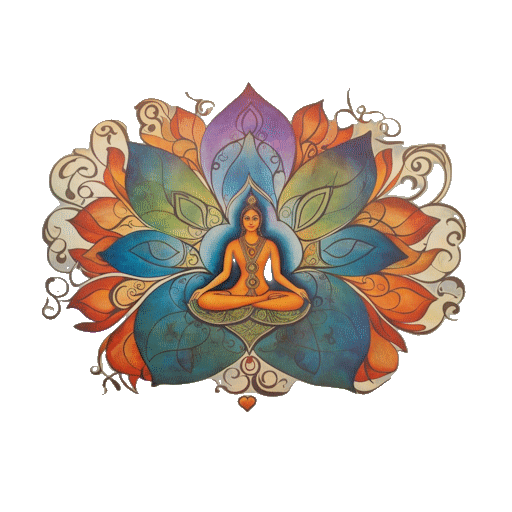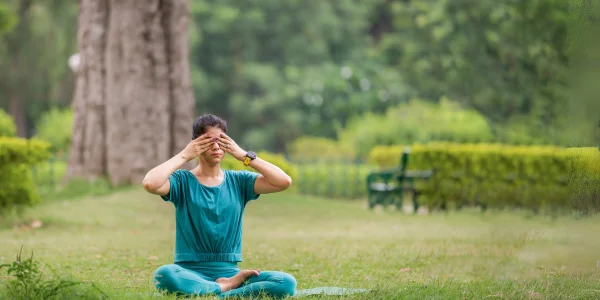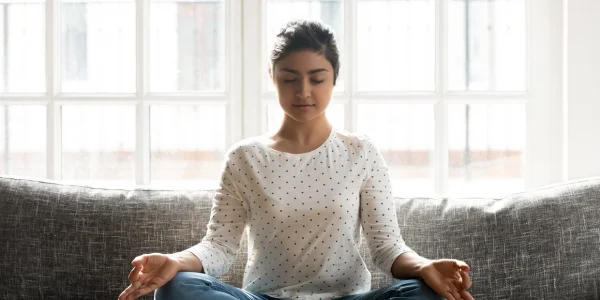Have you ever felt like you needed a break from the noise of everyday life? Imagine taking a journey that’s not about seeing new places, but about discovering a new side of yourself. This is where Vipassana meditation comes in. It’s not just any meditation; it’s like hitting the reset button for your mind.
Vipassana, which means ‘to see things as they really are’, is a form of meditation that’s been around for thousands of years. It was rediscovered by Buddha over 2,500 years ago and has been helping people find peace and clarity ever since. Think of it as an ancient technique with a modern purpose: to help us deal with the stress and craziness of 21st-century life.
In a world where we’re constantly bombarded with information and distractions, Vipassana offers a way to unplug and reconnect with ourselves. It’s like a deep dive into your own mind, helping you understand your thoughts and feelings more clearly. The cool part? It’s not tied to any religion or belief system, so it’s open to everyone, regardless of background.
The heart of Vipassana is a 10-day retreat. Yes, you heard that right – 10 days! But it’s not your typical reclusion. It’s a chance to really focus on yourself, away from all the noise and distractions. During these days, you’ll learn how to meditate in a way that lets you observe your thoughts and feelings without getting caught up in them. It’s about learning to experience life as it is, not how we think it should be.
What is Vipassana?

Let’s break it down: Vipassana is a type of meditation, but it’s a bit different from what you might picture when you think of meditation. It’s not about chanting or focusing on a single thought. Instead, it’s about training your mind to observe what’s happening inside it without judging or reacting. It’s like being a scientist of your own mind, watching your thoughts and feelings as they come and go.
Originally from the Buddhist tradition, Vipassana has been around for a really long time – we’re talking over 2,500 years! But don’t worry, you don’t need to be a Buddhist, or even religious, to practice it. It’s all about personal experience and self-understanding, which is pretty universal, right?
Vipassana had a resurgence when a Burmese man named Sayagyi U Ba Khin, in the 20th century, brought this ancient practice back into the public eye. He was instrumental in reviving Vipassana, making it accessible not just to monks but to everyone interested in exploring the depths of their minds.
It’s like turning up the volume on the quiet voice inside you that often gets drowned out by the hustle and bustle of daily life.
The core idea of Vipassana is simple yet profound: by paying close attention to your own thoughts and senses, you can learn a lot about how your mind works. It’s like turning up the volume on the quiet voice inside you that often gets drowned out by the hustle and bustle of daily life. This practice helps you become more aware of the present moment, which is a super useful skill to have, especially when life gets hectic.
Now, you might be thinking, “Okay, but what does this actually involve?” Well, during Vipassana meditation, you sit quietly and start paying attention to your breathing, and then to the physical sensations throughout your body. The goal is not to clear your mind of thoughts – that’s a common misconception. Instead, it’s about noticing your thoughts and feelings without getting swept away by them. It’s like watching cars pass by on a street without jumping into every single one.
One of the coolest things about Vipassana is that it’s all about direct experience. It’s not just theory or philosophy; it’s a practical tool you can use to understand yourself better and, as a result, handle life’s ups and downs more effectively. By practicing Vipassana, you can develop a sense of inner calm and clarity, which can be a game-changer in our often chaotic world.
You Might Also Like:
The Unique Approach of Vipassana Meditation
So, what makes Vipassana stand out from other types of meditation? It’s all about its unique approach. While many techniques focus on relaxation or visualization, Vipassana takes a different path. It’s like taking a deep dive into the ocean of your mind, exploring the depths that often go unnoticed.

First off, Vipassana is incredibly straightforward. There are no mantras, no special poses, and no need for any equipment. You just sit, observe your breath, and pay attention to your body’s sensations. It’s meditation in its simplest form, but don’t let that simplicity fool you – it’s powerful.
The key to Vipassana is mindfulness, which is a trendy word these days. But here, it’s not just a buzzword; it’s the essence of the practice. Mindfulness in Vipassana means being fully present and aware of what’s happening in the here and now. It’s about noticing everything that’s going on in your mind and body, moment by moment, without getting caught up in it.
Another unique aspect of Vipassana is its focus on transience. This is a big concept in Buddhist thought, but in Vipassana, it’s not just a theory; it’s something you experience firsthand. As you meditate, you start to see how your thoughts and feelings come and go. They’re always changing, just like everything else in life. This insight can be really eye-opening. It helps you understand that no matter how tough things get, they’re not going to last forever. This can be a huge relief, especially during tough times.
Vipassana also teaches you not to react. Normally, we react to things all the time – we get annoyed by a comment, stressed by a deadline, or excited by good news. In Vipassana, you learn to observe these reactions without getting swept away by them. It’s like building a mental muscle that helps you stay calm and centered, even when life throws curveballs at you.
In summary, Vipassana’s unique approach is all about simplicity, mindfulness, understanding impermanence, and learning not to react. This might sound a bit challenging, and honestly, it can be at first. But many people find that with practice, Vipassana can be a powerful tool for understanding themselves better and living a more mindfully peaceful life.
Understanding the 10-Day Vipassana Retreat
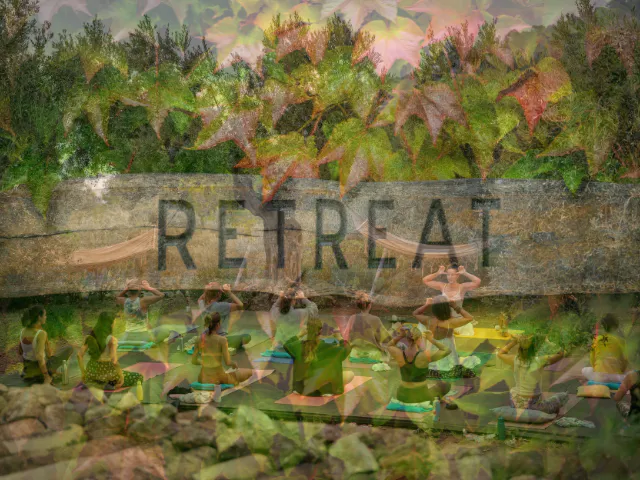
The Vipassana retreat is where the theory of meditation turns into a real, immersive experience. It’s like a boot camp for your mind, where you get to practice and understand Vipassana in a dedicated, distraction-free environment.
So, what’s so special about these 10 days? First, it’s about immersion. For ten days, you live in a retreat center, away from the usual demands and distractions of daily life. This setting provides the perfect backdrop for deep meditation and self-reflection. It’s like pressing pause on your regular life to focus entirely on your inner self.
During the retreat, you follow a strict schedule. Your day typically starts early in the morning and involves several hours of meditation. But it’s not just back-to-back meditation sessions. The day is structured to include time for rest, meals, and even short breaks for walking or relaxation. The idea is to maintain mindfulness throughout the day, not just during meditation sessions.
One of the most distinctive features of the retreat is the practice of noble silence. From the moment you arrive until the end of the course, you refrain from talking to other participants. This silence is more than just not speaking; it’s about withdrawing from all forms of communication, including gestures or eye contact. This might sound intense, but it’s actually a powerful tool. It helps you focus inward and minimizes distractions, allowing for deeper self-exploration.
The meditation practices itself during the retreat is rigorous. You’ll be guided through all the techniques, starting with focusing on your breath and then observing bodily sensations. The meditation sessions are interspersed with teachings and instructions, often given by experienced teachers or through recorded lectures by S.N. Goenka, a prominent teacher in the Vipassana tradition.
It’s important to note that these retreats are not a casual getaway. They can be challenging, both physically and emotionally. Sitting for long periods can be tough on your body, and the introspective nature of the practice can bring up all sorts of emotions. But this intensity is part of what makes the retreat so transformative. It’s an opportunity to confront and understand your inner self, free from the usual distractions of life.
At the end of the 10 days, many participants report feeling a sense of clarity, calm, and insight into their own lives. It’s not just about learning a contemplation technique; it’s about experiencing a profound inner transformation. Whether you’re seeking peace, clarity, or a deeper understanding of yourself, the 10-day Vipassana retreat offers a unique and potentially life-changing opportunity.
The Role of Silence in Vipassana

In the world of Vipassana meditation, silence is more than just a lack of noise; it’s a key part of the journey. During the ten day Vipassana retreat, the practice of maintaining silence, known as ‘noble silence,’ plays a crucial role. It’s not just about not speaking; it’s about cultivating inner stillness and deepening your meditation experience.
Think of noble silence as a tool that helps you turn your attention inward. Without the usual chatter and small talk, you get a rare chance to disconnect from the external world and tune into your own thoughts and feelings. It’s like turning off the noise from the outside so you can hear what’s going on inside more clearly.
This silence isn’t just about not talking to others. It also extends to avoiding eye contact and any form of non-verbal communication. The idea is to minimize distractions as much as possible. This might sound a bit extreme, but it’s all about creating an environment where you can focus entirely on your meditation practice.
But why is this so important? In our everyday lives, we’re constantly communicating and interacting with others. This constant external engagement can make it hard for us to connect with our inner selves. By embracing silence, you give yourself the space to observe your own mind without the usual interruptions. It’s an opportunity to explore your thoughts and emotions from a place of detachment and clarity.
Noble silence also teaches you a lot about the nature of communication. You start to realize how much of our interaction is non-essential and how peaceful it can be to just be with yourself. This isn’t about becoming anti-social; it’s about learning to be comfortable with your own company and understanding yourself better.
For many, the experience of noble silence is transformative. It can be challenging at first, especially if you’re used to being constantly connected and engaged with others. But as the days go by, many find that the silence brings a sense of calm and clarity that’s hard to find in the hustle and bustle of everyday life.
In essence, the role of silence in Vipassana is about creating the right conditions for deep self-exploration and insight. It’s a unique aspect of the Vipassana retreat that can lead to profound personal growth and a deeper understanding of the mind.
Daily Schedule in a Vipassana Retreat
A typical day at a Vipassana retreat is carefully structured to support your meditation practice. It’s a mix of meditation sessions, rest, meals, and teachings, all designed to help you deepen your understanding of Vipassana. Let’s walk through what a day in a ten-day Vipassana retreat looks like:
Early Morning Wake-Up
Your day starts early, often around 4:00 AM. This might sound super early, but it’s a peaceful time for meditation. The quiet of the early morning helps in focusing and setting a calm tone for the day.
Morning Meditation
After waking up, you’ll have a morning meditation set. This is a time to practice the techniques you’ve learned, focusing on your breath and observing sensations in your body.
Breakfast and Rest
Following the morning meditation, there’s a breakfast break. This is not just a time to eat but also to rest and reflect on your practice. Even during meals and breaks, you’re encouraged to maintain mindfulness.
Group Meditation Sessions
The bulk of the day is spent in group meditation workshops in the meditation hall. These sessions are guided by an instructor or audio recordings of S.N. Goenka, providing instructions and insights into the practice.
Noon Meal and Rest
Lunch is usually the main meal of the day, followed by a rest period. This is a time to relax and recharge for the afternoon sessions. It’s also a time for quiet contemplation or walking meditation.
Afternoon Meditation
The afternoon continues with more meditation sessions. These sessions help you strengthen your practice and deepen your understanding of the meditation technique.
Evening Discourse
In the evening, there’s usually a discourse. These discourses offer practical wisdom, stories, and insights to support your meditation journey.
Night Meditation and Bedtime
The day ends with a final meditation session at night. This is a time to consolidate your practice for the day. After this session, it’s time to rest and prepare for the next day.
Throughout the day, you’re in an environment that supports your meditation practice. The schedule is intense, but it’s designed to help you immerse yourself fully in the practice of Vipassana. By the end of the 10 days, you’ll have developed a solid foundation in Vipassana meditation and gained insights that can be transformative.
The Three Meditation Stages in Vipassana
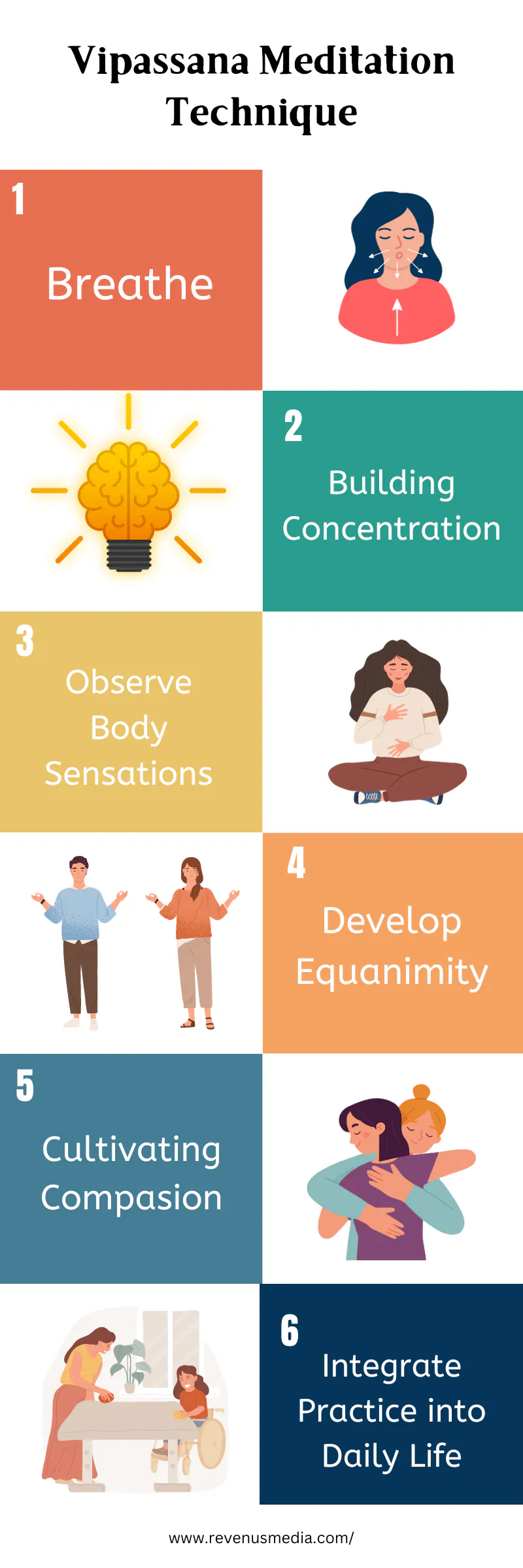
Vipassana meditation is more than just sitting quietly; it’s a structured process that unfolds in stages. Understanding these stages can help demystify what happens during a retreat and how each stage contributes to the overall journey of self-discovery and mindfulness.
Stage One: Anapana Meditation
- Focus on Breathing: The first stage is all about sharpening your focus and calming the mind. Here, you practice Anapana meditation, which involves concentrating on your breath. You pay attention to the sensation of the breath as it enters and exits your nostrils. This stage is crucial as it prepares your mind, making it more receptive to the deeper work of Vipassana meditation.
- Building Concentration: By focusing on something as simple and constant as your breath, you train your mind to concentrate and be present. This stage lays the groundwork for the more intensive observation that comes next in Vipassana.
Stage Two: Vipassana Meditation
- Observing Body Sensations: In this stage, you move your focus from the breath to observing sensations throughout your body. This could be anything from heat, cold, tingling, or pressure. The key is to observe these sensations without reacting to them.
- Learning Equanimity: Here, you practice composure by observing sensations without craving pleasant ones or avoiding unpleasant ones. This stage teaches you a lot about how your mind reacts to different experiences and how you can maintain balance and composure.
Stage Three: Metta Bhavana (Loving Kindness)
- Cultivating Compassion: The final stage of the Vipassana retreat is Metta Bhavana, or the practice of loving-kindness. After spending days observing your mind and body, this stage involves opening your heart and cultivating feelings of goodwill and kindness towards yourself and others.
- Integration into Daily Life: This practice helps to balance the intense self-observation of Vipassana with a warm, compassionate attitude. It’s also a way to integrate the insights and calmness you’ve developed during the retreat into your everyday interactions and relationships.
Each of these stages plays a vital role in the Vipassana meditation process. They work together to create a comprehensive experience that not only teaches you how to meditate but also transforms how you relate to yourself and the world around you. By the end of the retreat, you’re not just equipped with a reflection technique; you’ve embarked on a path of continuous personal growth and mindfulness.
You Might Also Like:
The Transformative Impact of Vipassana Meditation
After understanding the techniques and structure of Vipassana, it’s crucial to explore its transformative impact. Vipassana is not just a meditation practice; it’s a journey that can profoundly change how you view yourself and the world around you.
Gaining a New Perspective on Life
- Insight into Impermanence: One of the most significant insights from Vipassana is the understanding of transiency. As you observe the constant changes in your sensations and thoughts, you begin to see the transient nature of everything around you. This understanding can lead to a more balanced and less reactive approach to life’s ups and downs.
- Breaking Old Patterns: Regular practice of Vipassana can help break the cycle of habitual reactions. You become more aware of your automatic responses and learn to pause before responding, giving you a choice in how you respond to situations.
Enhanced Self-Awareness and Mindfulness
- Deeper Self-Understanding: Through continuous observation of your inner self, you develop a deeper understanding of your thoughts, emotions, and motivations. This heightened self-awareness can lead to more authentic and fulfilling life choices.
- Living Mindfully: Vipassana encourages mindfulness in everyday activities. Whether you’re eating, walking, or talking, you learn to be fully present, enhancing the quality of your experiences and interactions.
Emotional Balance and Mental Clarity
- Managing Stress and Anxiety: The practice of observing sensations without attachment helps in managing stress and anxiety. You learn to experience emotions without being overwhelmed by them.
- Clarity of Thought: As your mind becomes less cluttered with reactive thoughts, you experience greater clarity and focus. This can improve decision-making and problem-solving abilities.
Improved Relationships and Compassion
- Empathy and Understanding: Vipassana can foster a sense of empathy and understanding towards others. Recognizing that everyone is subject to the same feelings of impermanence and suffering can lead to deeper, more compassionate relationships.
- Positive Social Interactions: With increased mindfulness and emotional balance, interactions with others can become more positive and meaningful. You’re more likely to respond with understanding and less likely to respond impulsively or negatively.
Long-Term Personal Growth
- Continuous Learning: Vipassana is a lifelong journey. Each meditation session is an opportunity to learn something new about yourself and the world.
- Sustainable Change: The changes brought about by Vipassana are often sustainable and long-lasting. It’s not about quick fixes but about developing skills and insights that support ongoing personal growth.
In summary, the transformative impact of Vipassana meditation extends far beyond the meditation cushion. It influences how you perceive and interact with the world, leading to a more alert, balanced, and compassionate life. For many, Vipassana becomes more than a practice; it becomes a way of living.
The Benefits of Vipassana Meditation
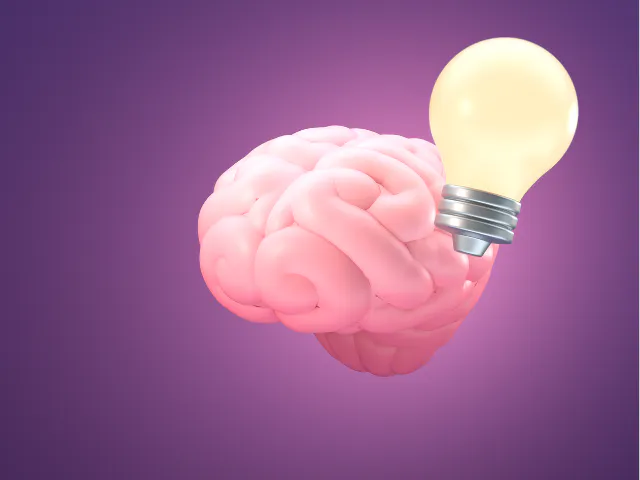
Vipassana meditation, with its unique approach and disciplined practice, offers a range of benefits that can profoundly impact your mental, emotional, and even physical well-being. Let’s explore some of the key benefits that practitioners often experience.
Mental Clarity and Focus
- Enhanced Concentration: Regular practice of Vipassana can significantly improve your ability to concentrate. By training your mind to focus on the present moment, you develop a sharper, more attentive mental state.
- Reduced Mental Clutter: Vipassana helps in decluttering the mind, and clearing away repetitive and unproductive thoughts, which often leads to a sense of mental spaciousness and clarity.
Emotional Well-being
- Stress Reduction: One of the most immediate benefits of Vipassana is stress relief. The practice encourages a calm and balanced approach to life’s challenges, reducing overall stress levels.
- Emotional Resilience: By observing your emotions without getting entangled in them, you develop greater emotional resilience. This helps in dealing with negative emotions like anger, anxiety, and sadness more effectively.
Physical Health
- Improved Physical Health: While Vipassana is primarily a mental practice, it can have positive effects on physical health. Reduced stress and a calm mind can lead to lower blood pressure, improved sleep, and a stronger immune system.
- Mind-Body Connection: Vipassana enhances your awareness of the mind-body connection, leading to a better understanding of how emotional and mental states can affect physical health.
Personal Growth and Self-Understanding
- Greater Self-Awareness: Vipassana meditation fosters deep self-awareness, helping you understand your thoughts, motivations, and reactions more clearly.
- Personal Transformation: Many practitioners report transformative experiences, leading to significant changes in their outlook on life, habits, and overall behavior.
Relationships and Social Well-being
- Improved Relationships: As you become more mindful and less reactive, your relationships can improve. Vipassana can help in developing empathy, patience, and better communication skills.
- Increased Compassion: The practice often leads to an increased sense of compassion and understanding towards others, fostering healthier and more positive social interactions.
Spiritual Development
- Spiritual Insight: For those on a spiritual path, Vipassana offers profound insights into the nature of existence, mindfulness, and the interconnectedness of all life.
- Inner Peace: Perhaps one of the most cherished benefits is the sense of inner peace and contentment that comes with regular practice.
In summary, the benefits of Vipassana meditation are comprehensive, touching every aspect of your life. Whether you’re seeking mental clarity, emotional stability, physical health, personal growth, or spiritual insight, Vipassana offers a path to achieving these goals through observant living and self-awareness.
Preparing for Your First Vipassana Retreat

Embarking on your first ten-day Vipassana retreat can be both exciting and daunting. Proper preparation is key to making the most of this unique experience. Here’s how you can get ready for this transformative journey:
Understanding the Commitment
- Mental Readiness: Acknowledge that a Vipassana retreat is intense and requires a strong commitment to stay for the entire duration. Prepare yourself mentally for the challenge and the opportunity for deep self-exploration.
Physical Preparation
- Adjusting Your Schedule: In the weeks leading up to the retreat, try to gradually adjust your sleeping and eating patterns closer to the retreat’s schedule. This can make the transition easier once you’re there.
- Practicing Sitting: Since you’ll be sitting for long periods during meditation, it’s helpful to practice sitting in a meditative posture for extended times to build up your physical endurance.
Packing Essentials
- Simple Clothing: Choose comfortable, modest clothing suitable for long hours of sitting and the retreat’s potentially quiet, reflective environment.
- Other Essentials: Bring personal hygiene items, any necessary medications, and perhaps a notebook for personal reflections (if allowed).
Mental and Emotional Preparation
- Setting Intentions: Reflect on what you hope to gain from the experience. Having a clear intention can help guide your focus during the retreat.
- Openness to Experience: Cultivate an attitude of openness and curiosity. Be prepared to encounter challenging moments and embrace them as part of the learning process.
Familiarizing Yourself with the Rules
- Understanding the Code of Conduct: Familiarize yourself with the retreat’s rules, including noble silence, no use of electronic devices, and other guidelines designed to minimize distractions and maximize introspection.
Practical Considerations
- Taking Care of Responsibilities: Ensure that your work, family, and other responsibilities are taken care of in your absence, so you can attend the retreat with peace of mind.
Choosing the Right Vipassana Course
Selecting the right course is crucial for a fulfilling experience. With various Vipassana centers and courses available, here’s how you can choose one that aligns best with your needs and expectations:
Research Different Centers
- Location and Accessibility: Consider the location of the Vipassana center. Some people prefer a center close to home, while others might want to travel to a more remote location for a complete retreat experience.
- Center’s Reputation: Look into the center’s reputation and reviews from past participants. This can give you insights into the quality of the courses and the overall experience.
Understanding Different Course Formats
- Standard 10-Day Courses: These are the most common and provide a comprehensive introduction to Vipassana. Ideal for beginners.
- Shorter or Longer Courses: Some centers offer shorter introductory courses or longer, more intensive courses for experienced meditators. Choose based on your level of experience and comfort.
Instructor’s Background
- Teaching Style: Different instructors and centers might have variations in teaching styles. Research the background of the instructors and their approach to teaching Vipassana.
- Tradition and Lineage: Vipassana has various lineages, such as those following S.N. Goenka or other teachers. Consider which tradition resonates more with you.
Course Structure and Facilities
- Accommodation and Meals: Check what kind of accommodation and meals are provided. Comfort levels can vary, and it’s important to know what to expect.
- Daily Schedule: Look into the daily schedule of the course. Ensure that you’re comfortable with the level of discipline and the amount of meditation practice involved.
Personal Considerations
- Physical and Mental Readiness: Assess your physical and mental readiness for a course. If you have any health concerns, consult with the center to understand if the course is suitable for you.
- Time and Commitment: Ensure you can commit to the full duration of the course without distractions or the need to leave early.
Choosing the right Vipassana course involves considering your personal preferences, level of experience, and practical aspects like location and facilities. By selecting a course that aligns well with your needs, you set the stage for a more meaningful and enriching meditation experience.
You Might Also Like:
What to Expect and How to Prepare
Embarking on a Vipassana retreat is a unique experience, and knowing what to expect during the retreat itself can help you mentally and emotionally prepare for the journey ahead.
During the Retreat: A Deep Dive into Meditation
- Deepening Meditation Practice: Expect the meditation sessions to progressively deepen your practice. Each day builds upon the last, allowing you to explore more profound levels of self-awareness.
- Physical Sensations: Be prepared to experience a range of physical sensations during prolonged meditation, from discomfort to deeper physical insights. Learning to observe these sensations without reaction is a core part of the practice.
Emotional and Mental Journey
- Emotional Ups and Downs: It’s not uncommon to experience a rollercoaster of emotions during the retreat. You might encounter joy, sadness, frustration, or even old memories resurfacing.
- Mental Clarity: As the days progress, many participants experience increased mental clarity and insight, leading to moments of profound understanding or realizations about their lives.
The Role of the Teacher and Group Dynamics
- Guidance from Instructors: Instructors provide daily guidance and are available for questions and support. Their role is to help you navigate your meditation journey effectively.
- Group Setting: While you’ll be in silence, the group setting creates a shared energy and commitment that can be supportive. There’s a sense of collective journeying, even in silence.
Post-Retreat: Integration into Daily Life
- Reintegration: After the retreat, there’s often a period of adjustment as you reintegrate into your daily life. It’s important to give yourself time to adapt and reflect on your experiences.
- Applying Insights: Consider how you can apply the insights and practices from the retreat into your everyday life. This might involve regular meditation, mindfulness in daily activities, or changes in your perspective and reactions.
Practical Tips for Preparation
- Physical Fitness: Engage in light physical activities like walking or stretching in the weeks before the retreat to prepare your body for long sitting periods.
- Mental Readiness: Spend some time reflecting on your intentions for attending the retreat and mentally prepare for a period of introspection and self-discovery.
You Might Also Like:
Chia Seed Benefits: Nature’s Powerhouse In A Tiny Package
FAQ: Common Questions About Vipassana Retreats
What Should I Bring to a Vipassana Retreat?
Essentials: Pack comfortable clothing, personal hygiene items, and any necessary medications. Check with the retreat center if they have specific guidelines or restrictions on what to bring.
Avoid Distractions: Leave behind electronic devices, books, and journals, as these can distract from the experience of noble silence and introspection.
Can Beginners Attend a 10-Day Vipassana Course?
Open to All: Vipassana retreats are designed to be accessible to beginners as well as experienced meditators. No prior meditation experience is required.
Preparation: While challenging, beginners can prepare by familiarizing themselves with the practice of meditation and setting realistic expectations for the retreat.
How Does Vipassana Impact Daily Life After the Retreat?
Long-Term Benefits: Many participants report lasting benefits such as increased mindfulness, improved emotional regulation, and a deeper sense of inner peace.
Incorporating Practice: Integrating the principles of Vipassana into daily life, like regular meditation and mindful living, can enhance the long-term impact of the retreat.
Is It Normal to Feel Overwhelmed During the Retreat?
Emotional Intensity: It’s not uncommon to feel overwhelmed at times, as deep meditation can bring up intense emotions and thoughts.
Support System: Retreat centers have experienced instructors and a supportive environment to help you navigate these challenges.
What If I Can’t Sit Still for Long Periods?
Physical Adjustments: Most centers allow for reasonable adjustments to accommodate physical discomfort during meditation. It’s okay to mindfully adjust your posture if needed.
Gradual Adaptation: Your body gradually adapts to longer periods of sitting as the retreat progresses. Light stretching or walking meditation can also help.
